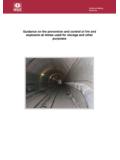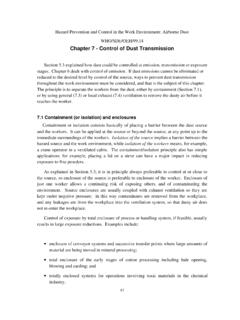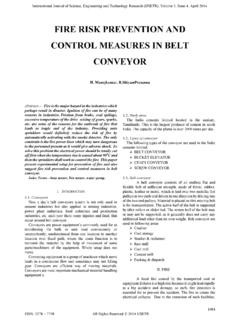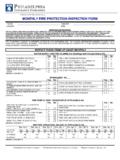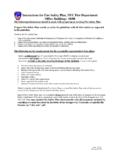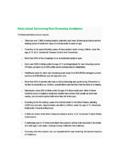Transcription of The prevention and control of fire and explosion in mines
1 Deep Mined Coal Industry Advisory Committee The Mining Association of the United Kingdom .. The prevention and control of fire and explosion in mines INTRODUCTION. This information and guidance was prepared, in consultation with the Health and Safety Executive (HSE), by a working group representative of all sides of the mining industry. It represents what members of the working group consider to be good practice. Members of the working group on the prevention and control of fire and explosion in mines .. Mr S Denton HM Inspector of mines , HSE, Chairman Mr A Allsop Union of Democratic Mineworkers Mr M Davies Tower Colliery Limited Mr P Fenner UK Coal Mining Limited Mr D Flack Federation of Independent mines Dr P Holmes British Gypsum Limited Mr S Hunneyball TES Bretby Limited Dr B Jones mines Rescue Service Limited Mr S Mills British Gypsum Limited Mr G Robinson Cleveland Potash Limited Mr N Rowley Cleveland Potash Limited Mr E Ruck UK Coal Mining Limited Mr R Young British Association of Colliery Management Mr G Goodlad HM Principal Inspector of Engineering in mines , HSE.
2 Mr R Leeming HM Inspector of mines , HSE. Mr M Williams HM Inspector of Mechanical Engineering in mines , HSE. Mr R Gates HSE, Working Group Secretary Papers only . Mr R Fenton The Mining Association of the United Kingdom Mr I Lavery National Union of Mineworkers 2. CONTENTS PAGES. 2. Contents pages .. 3. What this guide is about .. 5. Legal framework .. 6. Primary legislation .. 6. Provisions relating to worker protection .. 6. Provisions relating to the supply of 7. List of legislative provisions .. 8. fire and explosion risk assessment .. 9. Introduction.
3 9. Risk Assessment .. 9. Identifying the 9. Evaluating the likelihood of a fire or explosion .. 11. Deciding who might be harmed and how .. 12. Recording significant findings .. 12. Reviewing the assessments .. 12. Risk assessment and the emergency plan .. 13. fire and explosion prevention and control .. 13. fire Protection Plan .. 15. fire avoidance and control 16. Avoidance and control of sources of 16. Selection, and use of 16. Machinery and equipment monitoring .. 18. Inspection, testing and maintenance .. 20. Belt Conveyor Installations .. 21.
4 Naked lights/flame/hot 22. Smoking and smoking materials .. 23. Spontaneous combustion .. 23. control of flammable materials below 24. fire resistant materials in structures above and below ground .. 25. Toxic fumes from non-metallic 25. Detecting fires and raising the alarm .. 26. Particular situations .. 29. Alarm systems .. 31. Alarm levels .. 31. Testing and inspection .. 32. 3. fire fighting .. 32. fire -fighting measures .. 32. Selection and 32. fire extinguishers .. 33. On-board fire fighting systems .. 33. Other fire suppression systems .. 34.
5 Mains water fire -fighting 34. fire hoses .. 35. Inspection, testing and maintenance of 35. 36. Arrangements for 37. explosion Risk Assessment .. 38. The risk of explosion .. 38. explosion hazards .. 39. Assessing explosion risks .. 40. explosion Protection Plan .. 41. explosion control 42. 43. The selection of suitable equipment .. 43. Preventing an explosive atmosphere occurring .. 45. De-energising equipment used in potentially explosive atmospheres in mines .. 49. control of other ignition sources .. 51. Degassing operations .. 53. explosion mitigation measures.
6 54. Barriers .. 54. Equipment monitoring and protection ANNEX 1 .. 55. Further Guidance on spontaneous combustion ANNEX 2 .. 60. Examples of Ignition Hazard Assessments for Machinery and Equipment Intended for use in a Potentially Explosive Atmosphere ANNEX 3 .. 66. Example 1 - Ignition hazard assessment for a conveyor belt intended for use in a coal mine .. 66. Example 2 - Ignition hazard assessment for a shearer loader intended for use in a potentially explosive atmosphere of a coal mine .. 70. Law Relevant to fire and Explosions in mines ANNEX 4.
7 76. Approval of a Barrier to the Extension of Flame ANNEX 78. The Bagged Stonedust Barrier .. 87. 4. WHO SHOULD READ THIS BOOKLET? 1. This guidance is for all mines except storage mines . It should be read by: Mine owners Mine managers;. Other mine staff who have a role in ensuring explosion and/or fire safety through supervision, inspection and maintenance etc;. and may be useful to: Safety representatives;. Employee representatives;. Employees. It can be used as a tool for training and refresher training. 2. HSE has prepared separate guidance for mines or parts of mines used to store documents or items below ground.
8 WHAT THIS GUIDE IS ABOUT. 3. Fires and explosions have the potential to kill many people. This guidance tells you how to comply with the law; how to carry out fire and explosion risk assessments; and how to identify the measures necessary to avoid, control and mitigate those risks. It will help mine owners and managers to prepare their fire and explosion protection plans. 4. These risk assessments will also help mine managers to prepare their emergency plans setting out the action to be taken to effect the evacuation and rescue of people from below ground in the event of a fire or explosion .
9 5. While fire and explosion risk assessments have to be carried out both below ground and on the surface, this guidance relates primarily to fire and explosion risks below ground. However, the general principles should be applied to those buildings and equipment on the surface of a mine where a fire or explosion could prejudice safety below ground. For example, heapsteads, winding engine houses, firedamp drainage houses, fan houses and main ventilating fans. 6. The fire Precautions (Workplaces) Regulations 1999 and the fire Precautions (Special Premises) Regulations 1971 apply above ground at mines .
10 For general guidance on these and other fire safety legislation, and on fire and explosion precautions above ground, refer to the HSE/Home Office guidance fire Safety, An Employer's Guide', ISBN 0-11-341229-0. 5. LEGAL FRAMEWORK. Primary legislation 7. The two main pieces of primary health and safety legislation (Acts of Parliament) relevant to fire and explosion in mines are: The mines and Quarries Act 1954, which includes provisions that have a bearing on fire and explosion . The Health and Safety at Work etc Act 1974, which contains duties relating to safe systems of work and ensuring the health and safety of employees and others who may be affected by a work activity.










